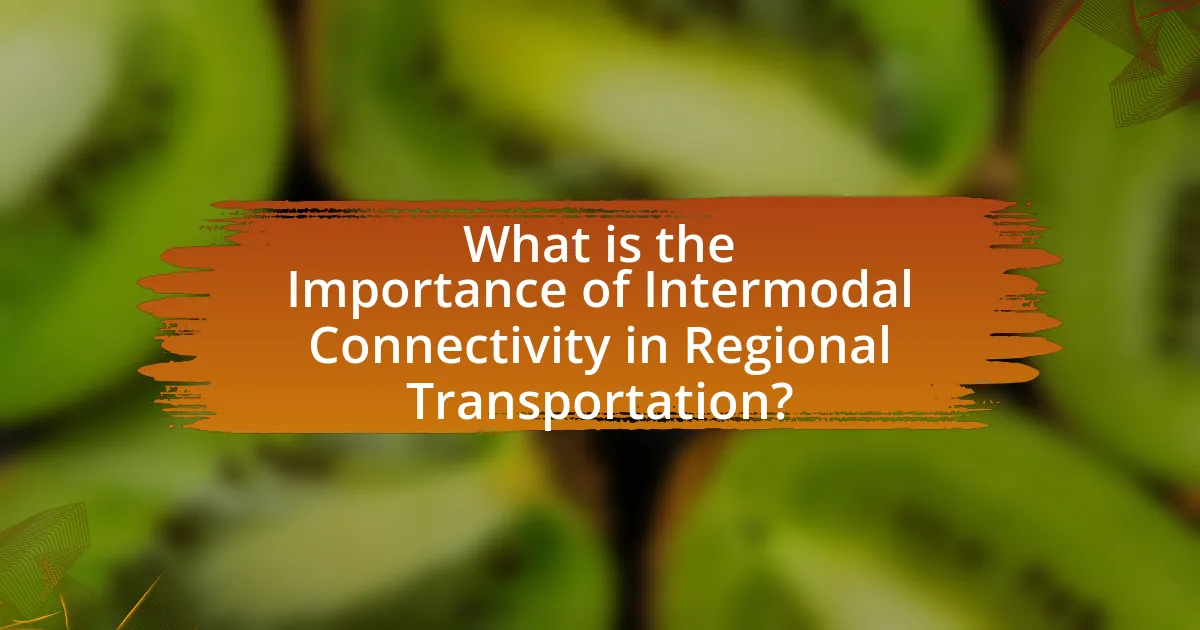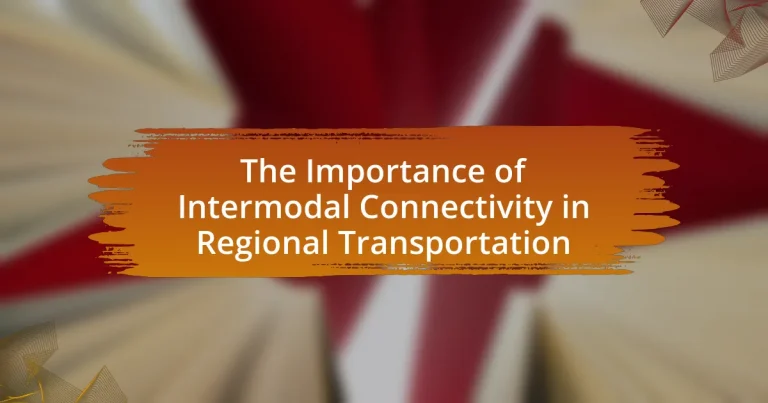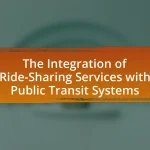Intermodal connectivity is a vital aspect of regional transportation that integrates various modes of transport, such as rail, road, and maritime, to enhance efficiency, reduce costs, and improve accessibility. This article examines the significance of intermodal systems in optimizing the movement of goods and people, highlighting their role in economic growth, supply chain efficiency, and environmental sustainability. Key components of intermodal connectivity, including infrastructure, operational coordination, and technology, are discussed, along with the challenges faced in implementation and strategies for improvement. The article emphasizes the benefits of intermodal connectivity in reducing transit times, lowering emissions, and fostering job creation within local economies.

What is the Importance of Intermodal Connectivity in Regional Transportation?
Intermodal connectivity is crucial in regional transportation as it enhances efficiency, reduces costs, and improves accessibility. By integrating multiple modes of transport—such as rail, road, and maritime—regions can optimize the movement of goods and people, leading to decreased transit times and lower emissions. For instance, a study by the American Association of State Highway and Transportation Officials (AASHTO) highlights that intermodal systems can reduce transportation costs by up to 30% compared to single-mode transport. This connectivity fosters economic growth by facilitating trade and attracting investments, ultimately benefiting local communities and economies.
How does intermodal connectivity enhance regional transportation systems?
Intermodal connectivity enhances regional transportation systems by integrating multiple modes of transport, such as rail, road, and air, to create a seamless flow of goods and passengers. This integration reduces transit times and costs, as evidenced by studies showing that intermodal transport can lower shipping costs by up to 30% compared to single-mode transport. Additionally, improved intermodal connectivity leads to increased efficiency and reliability in logistics, facilitating better access to markets and reducing congestion on roadways. For instance, the implementation of intermodal terminals has been shown to increase freight capacity and decrease delivery times, thereby supporting economic growth in the region.
What are the key components of intermodal connectivity?
The key components of intermodal connectivity include infrastructure, transportation modes, and operational coordination. Infrastructure encompasses terminals, ports, and interchanges that facilitate the transfer of cargo between different transport modes, such as rail, road, and maritime. Transportation modes refer to the various means of moving goods, which must be integrated effectively to ensure seamless transitions. Operational coordination involves the synchronization of schedules, communication systems, and logistics management to optimize the flow of goods across different transport networks. These components work together to enhance efficiency and reduce transit times in regional transportation systems.
How do different modes of transport interact within intermodal systems?
Different modes of transport interact within intermodal systems by facilitating seamless transitions between various transportation methods, such as rail, road, air, and maritime. This interaction enhances efficiency and reduces transit times, as cargo can be transferred from one mode to another without significant delays. For instance, a study by the European Commission highlights that intermodal transport can reduce logistics costs by up to 30% compared to single-mode transport. Additionally, the integration of technology, such as tracking systems and standardized containers, further streamlines these interactions, ensuring that goods are moved efficiently across different transport networks.
Why is intermodal connectivity crucial for economic development?
Intermodal connectivity is crucial for economic development because it enhances the efficiency and effectiveness of transporting goods and services across different modes of transportation. By integrating rail, road, air, and maritime transport, businesses can reduce shipping times and costs, leading to increased competitiveness in the market. For instance, a study by the American Association of State Highway and Transportation Officials found that improved intermodal connections can lead to a 10-30% reduction in logistics costs, which directly contributes to economic growth. Furthermore, regions with robust intermodal systems attract more investments and create jobs, as companies seek locations that facilitate seamless movement of products.
What role does intermodal connectivity play in supply chain efficiency?
Intermodal connectivity significantly enhances supply chain efficiency by facilitating seamless transitions between different transportation modes, such as rail, road, and maritime. This integration reduces transit times and costs, as evidenced by a study from the American Association of Railroads, which found that intermodal shipping can lower transportation costs by 20-30% compared to traditional trucking. Additionally, improved intermodal connectivity minimizes delays and optimizes cargo handling, leading to better inventory management and increased reliability in delivery schedules. These factors collectively contribute to a more responsive and agile supply chain, ultimately driving greater operational efficiency.
How does intermodal connectivity impact job creation in regions?
Intermodal connectivity significantly enhances job creation in regions by facilitating efficient transportation of goods and people. Improved intermodal systems, such as integrated rail, road, and port facilities, reduce transit times and costs, attracting businesses that rely on logistics. For instance, a study by the American Transportation Research Institute found that regions with robust intermodal facilities experience a 10-15% increase in logistics-related jobs. This increase occurs as businesses expand operations to leverage the enhanced connectivity, leading to direct job creation in transportation, warehousing, and distribution sectors. Additionally, the availability of efficient transport options can stimulate local economies by attracting new industries and encouraging workforce mobility, further contributing to job growth.
What challenges does intermodal connectivity face in regional transportation?
Intermodal connectivity in regional transportation faces several challenges, including infrastructure limitations, coordination among different transport modes, and regulatory hurdles. Infrastructure limitations arise from inadequate facilities that do not support seamless transfers between modes, such as insufficient intermodal terminals or poor road and rail connections. Coordination challenges stem from the need for effective communication and scheduling between various transport operators, which can lead to delays and inefficiencies. Regulatory hurdles often involve differing standards and regulations across transport modes, complicating the integration process. These challenges hinder the efficiency and effectiveness of regional transportation systems, impacting overall mobility and economic growth.
What are the common barriers to implementing intermodal systems?
Common barriers to implementing intermodal systems include lack of infrastructure, regulatory challenges, and insufficient funding. The absence of integrated facilities and connections between different transport modes hinders seamless transitions for cargo and passengers. Regulatory challenges arise from differing standards and policies across jurisdictions, complicating coordination. Additionally, limited financial resources restrict investment in necessary infrastructure upgrades and technology, which are crucial for effective intermodal operations. These barriers collectively impede the development and efficiency of intermodal transportation systems.
How can regions overcome these challenges to improve connectivity?
Regions can overcome challenges to improve connectivity by investing in integrated transportation systems that facilitate seamless transfers between different modes of transport. This approach includes developing infrastructure that supports intermodal hubs, enhancing public transit options, and implementing technology for real-time data sharing. For instance, cities that have established multimodal transport centers, such as the one in Hamburg, Germany, have seen increased efficiency and reduced travel times, demonstrating the effectiveness of coordinated transport solutions. Additionally, collaboration among local governments, private sectors, and community stakeholders is essential to align resources and strategies, as evidenced by successful initiatives in regions like the San Francisco Bay Area, where partnerships have led to improved transit services and connectivity.
How does intermodal connectivity influence environmental sustainability?
Intermodal connectivity significantly enhances environmental sustainability by optimizing transportation efficiency and reducing greenhouse gas emissions. By integrating multiple modes of transport, such as rail, road, and maritime, intermodal systems facilitate the movement of goods in a more energy-efficient manner. For instance, rail transport emits approximately 45% less carbon dioxide per ton-mile compared to trucking, which highlights the environmental benefits of shifting freight from road to rail. Furthermore, intermodal connectivity minimizes congestion and lowers fuel consumption, contributing to improved air quality and reduced reliance on fossil fuels. Studies indicate that regions with robust intermodal networks experience a decrease in overall transportation emissions, underscoring the critical role of intermodal connectivity in promoting sustainable transportation practices.
What are the environmental benefits of using intermodal transportation?
Intermodal transportation significantly reduces environmental impact by lowering greenhouse gas emissions and energy consumption. This mode of transport combines multiple forms of transportation, such as rail and truck, which optimizes fuel efficiency. For instance, rail transport emits approximately 45% less carbon dioxide per ton-mile compared to trucking. Additionally, intermodal systems can reduce road congestion, leading to decreased air pollution and improved urban air quality. Studies indicate that shifting freight from road to rail can cut emissions by up to 75%, showcasing the substantial environmental benefits of intermodal transportation.
How does intermodal connectivity reduce carbon emissions in regional transport?
Intermodal connectivity reduces carbon emissions in regional transport by enabling the efficient transfer of goods and passengers between different modes of transportation, such as rail, road, and waterways. This efficiency minimizes reliance on carbon-intensive transport methods, as shifting freight from trucks to trains can reduce emissions by up to 75% per ton-mile. Additionally, intermodal systems optimize routes and consolidate shipments, leading to fewer trips and lower overall fuel consumption. Studies indicate that regions with robust intermodal networks experience a significant decrease in greenhouse gas emissions, highlighting the environmental benefits of integrated transport solutions.
What best practices can enhance intermodal connectivity in regional transportation?
Best practices that can enhance intermodal connectivity in regional transportation include the development of integrated transportation hubs, implementation of real-time data sharing systems, and establishment of standardized protocols across different transport modes. Integrated transportation hubs facilitate seamless transfers between modes, reducing travel time and improving user experience. Real-time data sharing systems enable better coordination among transport providers, allowing for timely updates on schedules and availability, which enhances reliability. Standardized protocols across various transport modes ensure compatibility and efficiency, making transitions smoother for passengers and freight. These practices are supported by studies indicating that regions with well-coordinated intermodal systems experience increased ridership and reduced congestion, demonstrating their effectiveness in improving connectivity.
How can technology improve intermodal connectivity solutions?
Technology can improve intermodal connectivity solutions by enhancing data integration and real-time tracking across different transportation modes. For instance, the implementation of Internet of Things (IoT) devices allows for seamless communication between various transport systems, enabling better coordination and efficiency. According to a study by the International Transport Forum, the use of advanced data analytics can reduce delays by up to 30% in intermodal transport operations. Additionally, platforms that aggregate data from multiple sources facilitate better decision-making and resource allocation, ultimately leading to more efficient logistics and reduced operational costs.
What strategies can regional planners adopt to foster intermodal connectivity?
Regional planners can adopt strategies such as developing integrated transportation hubs, enhancing multimodal infrastructure, and implementing coordinated scheduling to foster intermodal connectivity. Integrated transportation hubs facilitate seamless transfers between different modes of transport, improving user experience and efficiency. Enhancing multimodal infrastructure, such as dedicated bike lanes and pedestrian pathways, encourages the use of various transport modes. Coordinated scheduling among transit services minimizes wait times and maximizes connectivity, as evidenced by successful implementations in cities like Portland, Oregon, where transit agencies collaborate to synchronize timetables, resulting in increased ridership and reduced travel times.


